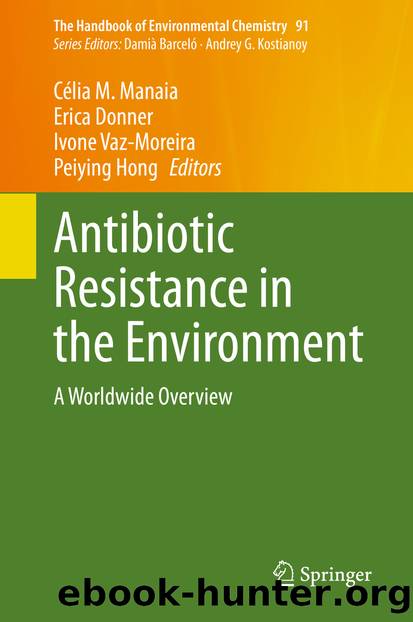Antibiotic Resistance in the Environment by Unknown

Author:Unknown
Language: eng
Format: epub
ISBN: 9783030550653
Publisher: Springer International Publishing
4.3.2 UV Irradiation
Ultraviolet (UV) disinfection is an alternative to chlorine since it does not produce toxic disinfection by-products, prompting many WWTPs to switch from chlorine to UV, or applying chlorine and UV in combination. UV radiation damages bacterial cells by targeting the DNA molecule, which may result in inhibition of replication and a subsequent decrease in proliferation [109]. In drinking water disinfection processes, energy-rich UV-C light with wavelengths of 200–260 nm has been successfully used to inactivate microorganisms for decades [96, 110, 111]. However, the application of UV disinfection is limited in turbid wastewater, because high levels of suspended particles significantly decrease the efficiency of the UV radiation. In addition, microorganisms can possess several mechanisms such as photoreactivation, base excision repair (BER), nucleotide excision repair (NER), and mismatch repair (MMR) to ensure cell survival after UV-light treatment [112]. DNA damage also can be tolerated by bacteria to a certain extent by use of DNA repair mechanisms [113]. Additionally, double-strand break repair (by homologous recombination and nonhomologous end joining), SOS response, cell-cycle checkpoints, and programmed cell death (apoptosis) are also operative in various organisms with the expense of specific gene products [112].
As a disinfectant, UV irradiation inactivates most microorganisms and achieves reduction from 1 to 6 logs (Table 4). Relatively high inactivation efficiencies (3.4–4.2 logs) were observed for total bacteria as well as ARB in swine wastewater at fluence of 220 mJ/cm2 [114]. The results confirmed that UV light can penetrate UV-transparent structures into the cell and is primarily absorbed by the nucleobases comprising DNA and RNA [115]. However, very low ARG removal efficiencies (0.36–0.60-log of sul1, tetX, tetG, intI1) were observed at UV fluence of 249.5 mJ/cm2 [93]. Higher eARG (3–4 logs) removal efficiencies could be achieved, compared to that of iARGs, at the UV dosage of 400 mJ/cm2, indicating that UV was limited in its potential to damage iARGs [110]. Although bacteria can be inactivated, DNA may be still present in the treated water, which can be helpful for the regrowth of the surviving cells and may contribute to the spread of antibiotic resistance [95, 96, 116]. In order to improve the disinfection performance for real wastewater, H2O2 has been incorporated with UV radiation to generate highly reactive free OH• to damage the bacterial cell structure by increasing the oxidation potential and degrading the intracellular DNA after 90 min treatment [117].
Download
This site does not store any files on its server. We only index and link to content provided by other sites. Please contact the content providers to delete copyright contents if any and email us, we'll remove relevant links or contents immediately.
| Automotive | Engineering |
| Transportation |
Whiskies Galore by Ian Buxton(41528)
Introduction to Aircraft Design (Cambridge Aerospace Series) by John P. Fielding(32888)
Small Unmanned Fixed-wing Aircraft Design by Andrew J. Keane Andras Sobester James P. Scanlan & András Sóbester & James P. Scanlan(32573)
Craft Beer for the Homebrewer by Michael Agnew(17932)
Turbulence by E. J. Noyes(7700)
The Complete Stick Figure Physics Tutorials by Allen Sarah(7137)
Kaplan MCAT General Chemistry Review by Kaplan(6595)
The Thirst by Nesbo Jo(6435)
Bad Blood by John Carreyrou(6274)
Modelling of Convective Heat and Mass Transfer in Rotating Flows by Igor V. Shevchuk(6222)
Learning SQL by Alan Beaulieu(6035)
Weapons of Math Destruction by Cathy O'Neil(5827)
Man-made Catastrophes and Risk Information Concealment by Dmitry Chernov & Didier Sornette(5645)
Digital Minimalism by Cal Newport;(5389)
Life 3.0: Being Human in the Age of Artificial Intelligence by Tegmark Max(5184)
iGen by Jean M. Twenge(5161)
Secrets of Antigravity Propulsion: Tesla, UFOs, and Classified Aerospace Technology by Ph.D. Paul A. Laviolette(4988)
Design of Trajectory Optimization Approach for Space Maneuver Vehicle Skip Entry Problems by Runqi Chai & Al Savvaris & Antonios Tsourdos & Senchun Chai(4839)
Electronic Devices & Circuits by Jacob Millman & Christos C. Halkias(4746)
